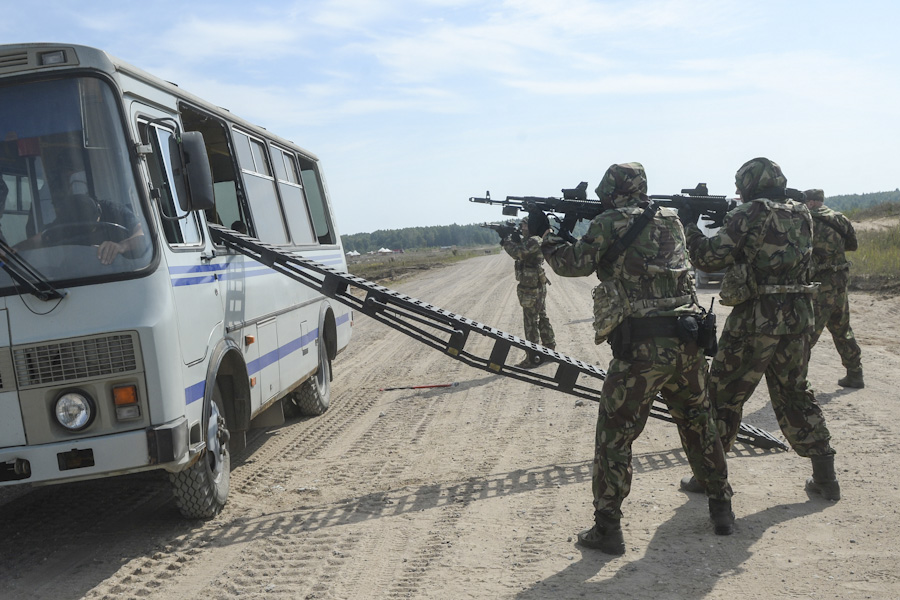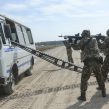
Russia Hosts CSTO Exercises in Western Military District
Publication: Eurasia Daily Monitor Volume: 12 Issue: 156
By:

In late August, Russia hosted military exercises for elite forces assigned to the Collective Security Treaty Organization (CSTO). Vzaimodeystviye (Collaboration) 2015 was staged near Pskov, in the Western Military District (MD), testing CSTO rapid reaction capabilities and unit interoperability. The scenario concentrated upon a crisis in a notional member state requiring assistance to restore its territorial integrity; and given the exercise’s location, it is highly likely to relate to a security crisis in Belarus. These themes, the current summer combat training program for Russia’s Armed Forces, the aims and objectives of its military exercises, and the nature of the CSTO exercise itself offer insight into the strategic climate pervading the Russian General Staff (Interfax, August 25, 24).
Vzaimodeystviye 2015 involved forces from the CSTO member states Russia, Armenia, Belarus, Kazakhstan, Kyrgyzstan and Tajikistan, jointly contributing to the Collective Rapid Reaction Forces (Kollektivnykh Sil Operativnogo Reagirovaniya—KSOR). Since its creation in 2009 the KSOR has relied heavily on Russian and Kazakhstani elite airborne units, with the CSTO’s economically and militarily weaker members offering smaller contributions. The bulk of the 2,000 KSOR exercise personnel were Russian, while only servicemen from Belarus and Kazakhstan arrived with their own equipment (RIA Novosti, August 22). In military terms, the exercise was designed to test the automated command-and-control post and plan a collective intervention to “localize” an armed conflict, and to “preserve the sovereignty, protect the constitutional order and restore the territorial integrity of a notional CSTO member state,” according to the CSTO secretariat (Interfax, August 25).
CSTO Deputy Secretary-General Colonel-General Valeriy Semerikov denied any linkage between the CSTO military exercise and ongoing exercises by the North Atlantic Treaty Organization (NATO) close to Russia’s borders. “I would not like our exercise to be seen as a counter to the exercise NATO is now holding in the West. Our exercise is a planned one and was given the go-ahead last year by the ministers of defense and the Security Council secretaries,” Semerikov explained. He added that the exercise involved a specialist study on the further development of the KSOR. “At present, the KSOR is mainly represented by airborne units, but we need to understand to what extent this is right. Perhaps the airborne groupings will need to be strengthened,” noted Colonel Nikolay Ponosenko, who is leading the study as the head of a 35-strong group from Russia, Belarus and Kazakhstan (Interfax, August 25; Vzglyad, August 28).
Colonel-General Vladimir Shamanov, the commander of the Russian Airborne Forces, stated that the accommodation and meals provided during the exercise were “first class,” with special attention paid to avoiding repeating meals and offering national cuisine to its participants. Russian military chefs prepared Central Asian dishes such as plov and kuyrdak, aimed at appealing to other nationalities while reminding them of the superior Russian defense capacity to not only supply military equipment but also to feed the forces in this manner (RIA Novosti, August 21).
During the active phase of the exercise, special forces and other force elements rehearsed joint action to fix, locate and ambush the route of a group carrying weapons and drugs. The KSOR command assessed the situation and issued orders to combat units to block and destroy “sabotage and reconnaissance groups and gangs, militias” (RIA Novosti, August 28). Airborne forces from each country jointly conducted an operation to seize and destroy an “enemy base,” and free hostages. Russian and Belarussian reconnaissance personnel landed in a predetermined area, with tactical units from Kyrgyzstan and Tajikistan transferred by helicopter to offer fire support, while Russian emergency ministry servicemen cooperated with Kazakhstani airborne troops in disaster management (Informburo, accessed August 31).
Vzaimodeystviye 2015 included multiple exercise vignettes in the scenario to extend across counter-narcotics, counter-insurgency and collective defense. Since a working group was tasked with further developing the KSOR based on the exercise, it is probable that it was used to justify force modification and tested the strengths and limits of the current structure. It is important to note that General Shamanov commanded the exercise, implying that a real KSOR operation would be under the operational control of the Russian VDV. Direct management during the exercise’s practical activities was entrusted to the deputy commander of the VDV for Peacekeeping Operations and KSOR, Major-General Alexander Viaznikova (Vzglyad, August 24).
The CSTO exercise took place during a busy summer training period: The past few months witnessed a Russian-Chinese exercise, Morskoye Vzaimodeystviye (Sea Collaboration) 2015, landing joint amphibious assault forces in two bays at the Klerk Peninsula. During the summer, Russian forces also undertook army maneuvers at the Tsugol range, in Russia’s Trans-Baykal Territory—an exercise called Selenga 2015. In addition, over 1,000 troops from the newly formed Arctic motor-rifle brigade were tasked with reconnaissance and search operations in the Arctic during an inter-service exercise in the Taymyr Peninsula; its main phase rehearsed the protection and defense of a key industrial site, including on the territory of the Norilsk Nickel mining company. Furthermore, the Russian logistics system conducted major exercises in six regions, while an additional exercise in Central MD concentrated on “moral and psychological support” for pre-combat troops. Finally, Nuclear, Biological and Chemical (NBC) troops in Central MD staged a clean-up exercise, while naval exercises occurred in the Baltic Fleet and the Caspian Flotilla. The chief of the General Staff, Army-General Valeriy Gerasimov, confirmed that the highlight of the training year will be Tsentr 2015. During Tsentr 2015, “considerable attention will be paid to the joint preparation of the armed forces and public authorities,” Gerasimov said, adding, “one of the goals of the exercise will be to make the management of multi-departmental personnel and materiel intended to address diverse challenges even more effective, and ensure continuous interaction in the conduct of joint actions” (Interfax, August 25).
Vzaimodeystviye 2015 seems to have been staged in this specific context, with heightened interest in the General Staff about refining and improving joint operations as well as Russian power structures working more closely with each other during future operations. The CSTO also appears set to modify the KSOR force structure, adding additional units to allow for greater flexibility and reduce overreliance on airborne units. Finally, these issues may suggest that during a prolonged Ukraine conflict, Moscow is less willing to commit to unilateral action on its periphery and thus needs a stronger CSTO set of options. Driving this process are General Staff fears about security crises close to Russian borders in various strategic directions and an awareness of possible overstretch based on having to fight multiple conflicts simultaneously.




